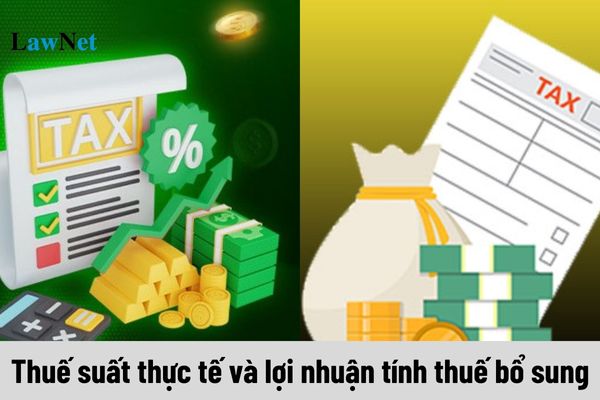How to determine the effective tax rate and top-up tax percentage in Vietnam?
How to determine the effective tax rate and top-up tax percentage in Vietnam?
Article 4 of Resolution 107/2023/QH15 provides regulations about the Qualified Domestic Minimum Top-Up Tax (QDMTT) as follows:
A constituent entity or a collection of constituent entities of a multinational group, as stipulated in Article 2 of Resolution 107/2023/QH15, operating or doing business in Vietnam during the fiscal year must apply regulations about the Qualified Domestic Minimum Top-Up Tax.
In case the constituent entity or a collection of constituent entities in Vietnam has income under the GloBE rules, and the effective tax rate in Vietnam is below the minimum tax rate, the Qualified Domestic Minimum Top-Up Tax in Vietnam is determined according to Clauses 2 and 9, Article 4 of Resolution 107/2023/QH15.
Where:
- The Qualified Domestic Minimum Top-Up Tax is calculated as follows:
Qualified Domestic Minimum Top-Up Tax = (Supplemental Tax Rate x top-up tax percentage) + Adjusted Supplemental Tax for the current year (if any).
- The supplemental tax rate is calculated as follows:
Supplemental Tax Rate = Minimum Tax Rate - effective tax rate.
- The minimum tax rate is 15%.
- The effective tax rate in Vietnam is calculated annually and determined as follows:
effective tax rate in Vietnam = Total Adjusted Corporate Income Tax in Vietnam during the Financial Year of the Constituent Entities in Vietnam / Net Income in Vietnam during the Fiscal Year under the GloBE rules
- top-up tax percentage is calculated as follows:
top-up tax percentage = Net Income under the GloBE rules - Deductible Value of Tangible Assets and Wages under the GloBE rules.
- Net income under the GloBE rules is determined as follows:
Net Income under the GloBE rules = Income under the GloBE rules of all Constituent Entities - Loss under the GloBE rules of all Constituent Entities.

How to determine the effective tax rate and top-up tax percentage in Vietnam? (Image from the Internet)
What entities are exempt from the global minimum tax?
According to Article 2 of Resolution 107/2023/QH15, it is clearly stipulated that the global minimum tax payer is the Constituent Entity of a multinational group with a consolidated revenue of no less than EUR 750 million in at least 2 of the 4 consecutive years preceding the fiscal year.
And seven entities are exempted from the global minimum tax starting from January 1, 2024, according to Resolution 107/2023/QH15, including:
- Government organizations;
- International organizations;
- Non-profit organizations;
- Pension funds;
- Investment funds being the ultimate parent entity;
- Real estate investment trusts being the ultimate parent entity;
- Organizations owning at least 85% of assets directly or indirectly through the above-mentioned organizations.
Vietnam: Where is the QDMTT paid according to the GloBE rules?
Based on Clause 4, Article 6 of Resolution 107/2023/QH15 regarding tax declaration, payment, and management:
Tax Declaration, Payment, and Management
...
3. The determination of the constituent entity for tax declaration and payment is regulated as follows:
a) A multinational group having one constituent entity in Vietnam shall have that entity submit the declaration and pay the QDMTT according to the GloBE rules;
b) A multinational group having more than one constituent entity in Vietnam shall notify and designate one of the entities in Vietnam to submit the declaration and pay the QDMTT of the group according to the GloBE rules within 30 days from the end of the fiscal year.
If 30 days from the end of the fiscal year elapse and the multinational group does not notify and designate a constituent entity in Vietnam for declaration and payment, the tax authority shall designate an entity for this purpose within 30 days from the elapse of the notification period;
c) In the event of a change in the constituent entity responsible for declaration and payment, the multinational group must inform the tax authority within 10 days of the occurrence. If not notified within the stipulated time, the tax authority shall notify the designation of a new responsible entity within 10 days of receiving the information;
d) If the tax authority has already designated a constituent entity responsible for declaration and payment according to point b or c of this clause, and receives information leading to a change in the responsible entity, the tax authority will notify the new designation within 10 days of receipt of the information.
4. The QDMTT according to the GloBE rules is paid into the central budget.
...
The QDMTT according to the GloBE rules is paid into the central budget.
Within these provisions, the GloBE rules, also known as the global base erosion tax regulation, is defined in Clause 1, Article 3 of Resolution 107/2023/QH15 as regulations within Resolution 107/2023/QH15 and those of the Vietnamese Government aligned with the global minimum tax framework of the Inclusive Framework on Base Erosion and Profit Shifting, of which Vietnam is a member.

